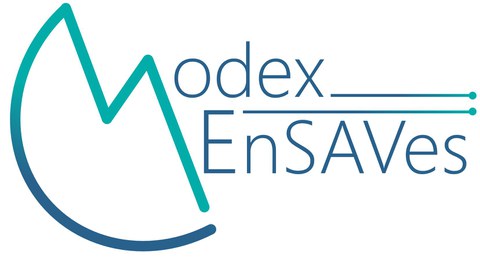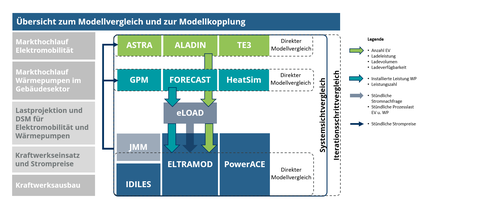MODEX-EnSAVes: Modellexperimente - Entwicklungspfade für neue Stromanwendungen und deren Auswirkungen auf kritische Versorgungssituationen
Hintergrund
Im Zuge der Energiewende entwickelt sich in Deutschland eine völlig neue Energielandschaft mit zunehmender Vernetzung und daraus resultierenden Wechselwirkungen zwischen der Vielzahl von Akteuren und neuen Technologien. Modellgestützte Energiesystemanalysen sind ein wichtiges Instrument, um diese komplexen Zusammenhänge und Wirkungsmechanismen zu verstehen. Auf dieser Grundlage können gezielt Impulse gesetzt werden, welche die Systementwicklung in die gewünschte Richtung vorantreiben sollen. Hierfür wurden in den vergangenen Jahrzehnten verschiedenste Modellansätze entwickelt, welche inzwischen ein sehr breites methodisches Spektrum aufweisen. Um vor diesem Hintergrund die Transparenz der Systemanalyse zu gewährleisten, gleichzeitig aber auch die stetige Verbesserung der Modelle voranzutreiben, sind in regelmäßigen Abständen vergleichende Gegenüberstellungen der Ansätze im Rahmen von Modellexperimenten anzustreben. In MODEX-EnSAVes soll ein methodisch orientierter Modellvergleich anhand eines konkreten Anwendungsfalls durchgeführt werden.
Ziel, Thematik und Methodik des Modellvergleichs
Ziel des Modellvergleichs ist es, die Ergebnisse unterschiedlicher Modellansätze zum Markthochlauf neuer Stromanwendungen zu vergleichen. Dabei fokussiert das Modellexperiment auf die Bereiche Elektromobilität und Wärmepumpen im Wohngebäudebereich, für die im Konsortium verschiedene detaillierte Modelle mit spezifischem Analysefokus zur Anwendung kommen. Da die Investitionsentscheidungen bei Fahrzeugen und Gebäudeheizsystemen von verschiedenen Akteuren getroffen werden, gibt es hier vielfältige Einflussfaktoren, die in den einzelnen Modellansätzen unterschiedlich abgebildet werden.
Gleichzeitig sind durch eine verstärkte Elektrifizierung auch Auswirkungen auf die Versorgungssicherheit zu erwarten und es stellt sich insbesondere die Frage, wie kritische Versorgungssituationen wie eine kalte „Dunkelflaute“ im Winter in Zukunft bewältigt werden können. Daher sollen die Modelle zur Nachfrageentwicklung mit Elektrizitätsmarktmodellen gekoppelt werden. Letztere sollen speziell für eine Analyse der zukünftigen Erzeugungssicherheit im Sinne der „generation adequacy“, d. h. der Angemessenheit der Erzeugungs- und sonstigen Backup-Kapazitäten für die Bewältigung von Perioden mit hoher Residuallast, eingesetzt werden. Dazu werden aus den nachfrageseitigen Modellen zukünftige erwartete Lastgänge für die neuen Stromanwendungen abgeleitet und diese als Input für die Elektrizitätsmarktmodelle verwendet.
Die Strommarktmodelle untersuchen, ob und wie die Elektrizitätsnachfrage zukünftig im Jahresverlauf unter Ausnutzung der Flexibilitätspotenziale der Erzeugungsanlagen und Nachfrageanwendungen gedeckt werden kann. Dabei soll der Fokus insbesondere auf ein Jahr mit extremen Wetterbedingungen gelegt werden. Durch den Vergleich der Ergebnisse soll abgeleitet werden, wie die Modellierung von Flexibilitätspotenzialen sich auf die Erzeugungssicherheit auswirken.
Projektlaufzeit: 2019 - 2021
Auftraggeber: Bundesministerium für Wirtschaft und Energie (BMWi)
Partner: ESA² GmbH, M-Five GmbH, Fraunhofer-Institut für System- und Innovationsforschung (ISI), Lehrstuhl für Energiewirtschaft am Karlsruher Institut für Technologie (KIT-IIP), Lehrstuhl für Energiewirtschaft der Universität Duisburg-Essen, Lehrstuhl für Energiewirtschaft an der TU Dresden (Koordinator)
ee2 Teammitglieder: Dominik Möst, Steffi Misconel
Ansprechpartnerin: Steffi Misconel (steffi.misconel@tu-dresden.de)
Webpräsenz: https://www.energiesystem-forschung.de/foerdern/modex/modex-ensaves
Poster: Poster_Modex-EnSAVes.pdf
Videopräsentation: Video_Modex-EnSAVes


